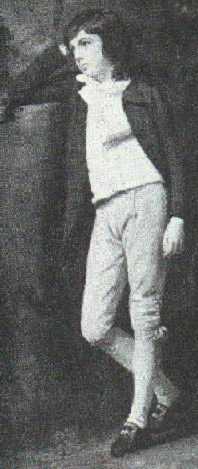William Courtenay, 9th Earl of Devon

William "Kitty" Courtenay, 9th Earl of Devon (c. 1768 – 26 May 1835), was the only son of William Courtenay, de jure 8th Earl of Devon, 2nd Viscount Courtenay and his wife Frances Clack. He attracted infamy for a homosexual affair with art collector William Beckford from boyhood when it was discovered and publicised by his uncle. From October 1788 until 1831, his official title was The Rt. Hon. The 3rd Viscount Courtenay of Powderham.
Family
Courtenay was baptized on 30 August 1768, the fourth of 14 children (his siblings all being girls) [2] and was known as "Kitty" to family and friends. On his father's death he became The 3rd Viscount Courtenay of Powderham. With his new title and wealth, the young Lord Courtenay led an excessively flamboyant lifestyle. He was responsible for the addition of a new Music Room at Powderham Castle, designed by James Wyatt, which included a carpet made by the newly formed Axminster Carpet Company.
Relationship with William Beckford
As a youth, 'Kitty' Courtenay was sometimes named by contemporaries as the most beautiful boy in England.[2] Courtenay was homosexual and became infamous for his affair with William Beckford; they had met when Courtenay was ten but Beckford, only 8 years his senior, was already a wealthy art collector and sugar plantation owner.
In the autumn of 1784, a houseguest overheard an argument between the then-18 year old Hon. (his title at that time) William Courtenay and Beckford over a note of Courtenay's. There is no record of what the note said, but the houseguest said that Beckford's response on reading it was that he entered Courtenay's room and "horsewhipped him, which created a noise, and the door being opened, Courtenay was discovered in his shirt, and Beckford in some posture or other — Strange story."[2] Beckford was subsequently hounded out of polite British society when his letters to Courtenay were intercepted by Courtenay's uncle, Lord Loughborough, who then publicised the affair in the newspapers.[3]
Later life
Courtenay was forced to live abroad, and lived in the United States where he owned a property on the Hudson River in New York, and later in Paris. He died unmarried, and fathered no known children.
In 1831, as The 3rd Viscount Courtenay, he successfully petitioned to revive the title of Earl of Devon for the head of the Courtenay family, that title having been dormant since 1556, and so became the 9th Earl.
He died on 26 May 1835 at age 66 in Paris due to natural causes. He was loved by his tenants, who insisted that he be buried in stately fashion. He was buried on 12 June 1835 in Powderham.
References
- ↑ French, Daniel, (ed.), Powderham Castle Guidebook, 2011, p.17
- ↑ 2.0 2.1 2.2 Bryson, Bill (2010). At Home: A Short History of Private Life. Great Britain: Doubleday. p. 148. ISBN 978-0-7679-1938-8.
- ↑ Gabrielle Griffin, "Who's Who in Gay and Lesbian Writing," (Routledge, New York, 2002), P.17
External links
- Hansard 1803–2005: contributions in Parliament by the Earl of Devon
| Peerage of England | ||
|---|---|---|
| Preceded by 2nd Viscount Courtenay |
Earl of Devon de jure until 1831 1788 – 1835 |
Succeeded by 10th Earl of Devon |
| 3rd Viscount Courtenay of Powderham 1788 – 1835 |
Extinct | |